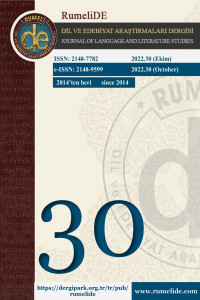Abstract
John Robert Fowles’ın kaleme aldığı Fransız Teğmenin Kadını adlı romanının bir yüzyıl boyunca romanın geçirdiği gelişimine de ışık tuttuğu söylenebilir. Viktorya dönemi anlatı üslubu, yüzyıl sonraya ait postmodern bir anlatı üslubu ile iç içedir ve bir yüzyıl sonra bir Viktorya dönemi romanı yazmanın zorlukları, yazar anlatıcı tarafından roman içinde dile getirilir. Viktorya Dönemi ve dönemin sosyo-dinamik yapısı hem farklı farklı bölüm başına konulan alıntılarla hem de anlatı üzerinden tasvir edilir. Aynı şekilde, zaman zaman bu zorluklara vurgu yapılarak böylesi bir roman yazma girişimlerinden açıkça bahsedilir ve ortaya çıkan bu ikili yaklaşım okuyucuyla paylaşılır. Ana hikâye devam ederken romanın geçirdiği bir yüzyıllık seyir, Viktorya dönemi unsurlarıyla beraberce verilir. Açıkçası postmodern bir romanın içinde varlık bulduğu bir Viktorya dönemi romanı söz konusudur. Her ikisini de bir roman içerisinde bir arada görmek mümkündür. Fowles, Viktorya Dönemi’nin genel kabullerine üstkurgusal manipülasyonlar yapar ve bununla beraber romanın bir yüzyılda boyunca katettiği gelişimi, Fransız Teğmenin Kadını'nın anlatı öyküsüne yerleştirir. Kısacası, Fowles bir taraftan romanın ana hikayesini sunarken diğer taraftan da iki farklı döneme ait roman tarzlarının oluşturduğu mükemmel bir harmanı başarılı bir şekilde gözler önüne serer.
References
- Brantlinger, P., Adam, I. & Rothblatt, S. (1972). “The French Lieutenant’s Woman: A Discussion”, Victorian Studies, Vol. 15, No. 3, pp. 339-356.
- Buchberger, Michelle Phillips (2009). Metafiction, Historiograpphy, and Mythopoeia in the Novels of John Fowles, Doctorate Thesis, London: Brunel University.
- Campbell, J. & Fowles, J. (1976). “An Interview with John Fowles”, Contemporary Literature, Autumn, Vol. 17, No. 4, pp. 455-469.
- Carter, R. & Mcrae , J. (2001). The Routledge History of Literature in English, (second edition), London: Routledge.
- Drabble, Margaret (1996). The Oxford Companion to English Literature, Oxford: Oxford University Press.
- Drzajic, Katarina (2013). “Victorian vs. Modern: Modality in the Language of The French Lieutenant’s Woman by John Fowles”, The Journal for Langıages and Literatures of the Faculty of Philosophy in Novi Sad, no. 3, pp. 179-189.
- Fowles, John (1969). The French Lieutenant’s Woman, (third edition), London: Little Brown and Company.
- Hakkioglu, Mumin (2019). “Metinlerarasılığın İzinde: David Lodge’un Dünya Küçük Adlı Romanında Metinsel Devinimler”, Çağdaş Edebiyatın Kuramsal Seyri, (ed. A. Oren & M. Hakkıoglu), Konya: Çizgi Press.
- Heptonstall, Geoffrey (1996). “The English Novel in the Twentieth Century: John Fowles”, Contemporary Criticism, Vol. 268, Issue 1564, pp. 262-266.
- Lodge, David (1992). Art of Fiction, New York: Viking Penguin.
- Onega, Susan (1996). “Self, World, and Art in the Fiction of John Fowles”, Twentieth Century Literature, Vol. 42, No.1, John Fowles Issue, pp. 29-56.
- Raimond, Lean (2005). İngiliz Edebiyatı, (translater: İ. Yerguz), Ankara: Dost Press.
- Tarbox, Katherine (1996). “The French Lieutenant’s Woman and the Evolution of Narrative”, Twentieth Century Literature, Vol. 42, No.1, John Fowles Issue, pp. 88-102.
Abstract
The French Lieutenant's Woman by John Robert Fowles can be said in a way to shed light on the development of novel in a century. The Victorian narrative style is side by side with the postmodern narrative style one hundred years later, and the difficulties of writing a Victorian novel from a century later are expressed by the author within the novel. The Victorian era and its socio-dynamic structure are depicted both with various epigraphs and through the narrative. Accordingly, attempts to write such a novel are clearly noted by emphasizing these difficulties from time to time and this dual approach is shared with the reader. While the main story progresses, the century-long adventure of novel is written within the Victorian elements. Apparently, there is the Victorian novel in which a postmodern novel comes into existence. It is possible to see both together. Fowles makes metafictional manipulations with the acceptances of the period and also embeds the novel's century-old progress into the story of The French Lieutenant's Woman. In short, while presenting the main story of the novel, Fowles successfully reveals the perfect harmony of the novel styles of two different eras.
References
- Brantlinger, P., Adam, I. & Rothblatt, S. (1972). “The French Lieutenant’s Woman: A Discussion”, Victorian Studies, Vol. 15, No. 3, pp. 339-356.
- Buchberger, Michelle Phillips (2009). Metafiction, Historiograpphy, and Mythopoeia in the Novels of John Fowles, Doctorate Thesis, London: Brunel University.
- Campbell, J. & Fowles, J. (1976). “An Interview with John Fowles”, Contemporary Literature, Autumn, Vol. 17, No. 4, pp. 455-469.
- Carter, R. & Mcrae , J. (2001). The Routledge History of Literature in English, (second edition), London: Routledge.
- Drabble, Margaret (1996). The Oxford Companion to English Literature, Oxford: Oxford University Press.
- Drzajic, Katarina (2013). “Victorian vs. Modern: Modality in the Language of The French Lieutenant’s Woman by John Fowles”, The Journal for Langıages and Literatures of the Faculty of Philosophy in Novi Sad, no. 3, pp. 179-189.
- Fowles, John (1969). The French Lieutenant’s Woman, (third edition), London: Little Brown and Company.
- Hakkioglu, Mumin (2019). “Metinlerarasılığın İzinde: David Lodge’un Dünya Küçük Adlı Romanında Metinsel Devinimler”, Çağdaş Edebiyatın Kuramsal Seyri, (ed. A. Oren & M. Hakkıoglu), Konya: Çizgi Press.
- Heptonstall, Geoffrey (1996). “The English Novel in the Twentieth Century: John Fowles”, Contemporary Criticism, Vol. 268, Issue 1564, pp. 262-266.
- Lodge, David (1992). Art of Fiction, New York: Viking Penguin.
- Onega, Susan (1996). “Self, World, and Art in the Fiction of John Fowles”, Twentieth Century Literature, Vol. 42, No.1, John Fowles Issue, pp. 29-56.
- Raimond, Lean (2005). İngiliz Edebiyatı, (translater: İ. Yerguz), Ankara: Dost Press.
- Tarbox, Katherine (1996). “The French Lieutenant’s Woman and the Evolution of Narrative”, Twentieth Century Literature, Vol. 42, No.1, John Fowles Issue, pp. 88-102.
Details
| Primary Language | English |
|---|---|
| Subjects | Linguistics |
| Journal Section | World languages, cultures and litertures |
| Authors | |
| Publication Date | October 21, 2022 |
| Published in Issue | Year 2022 Issue: 30 |

